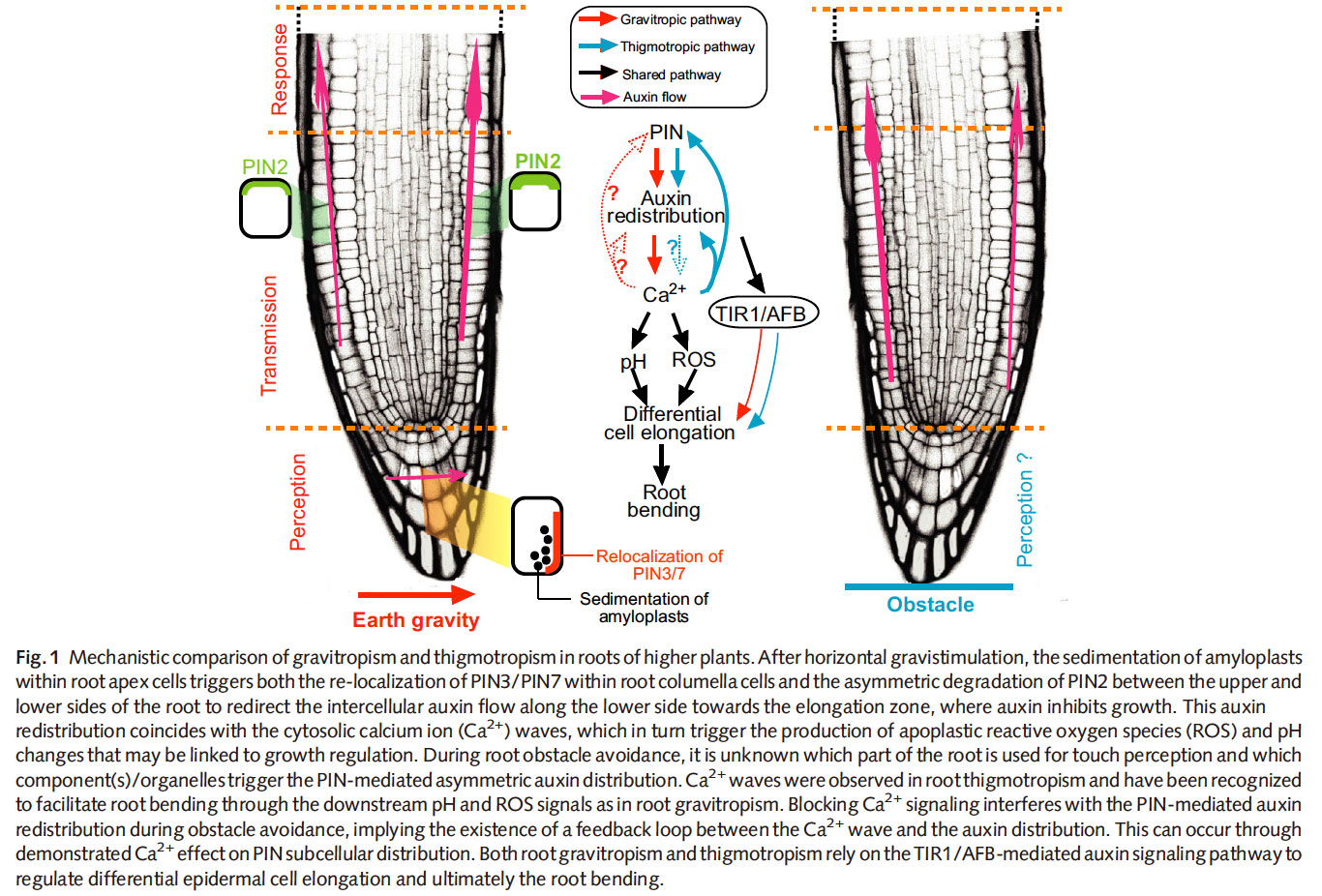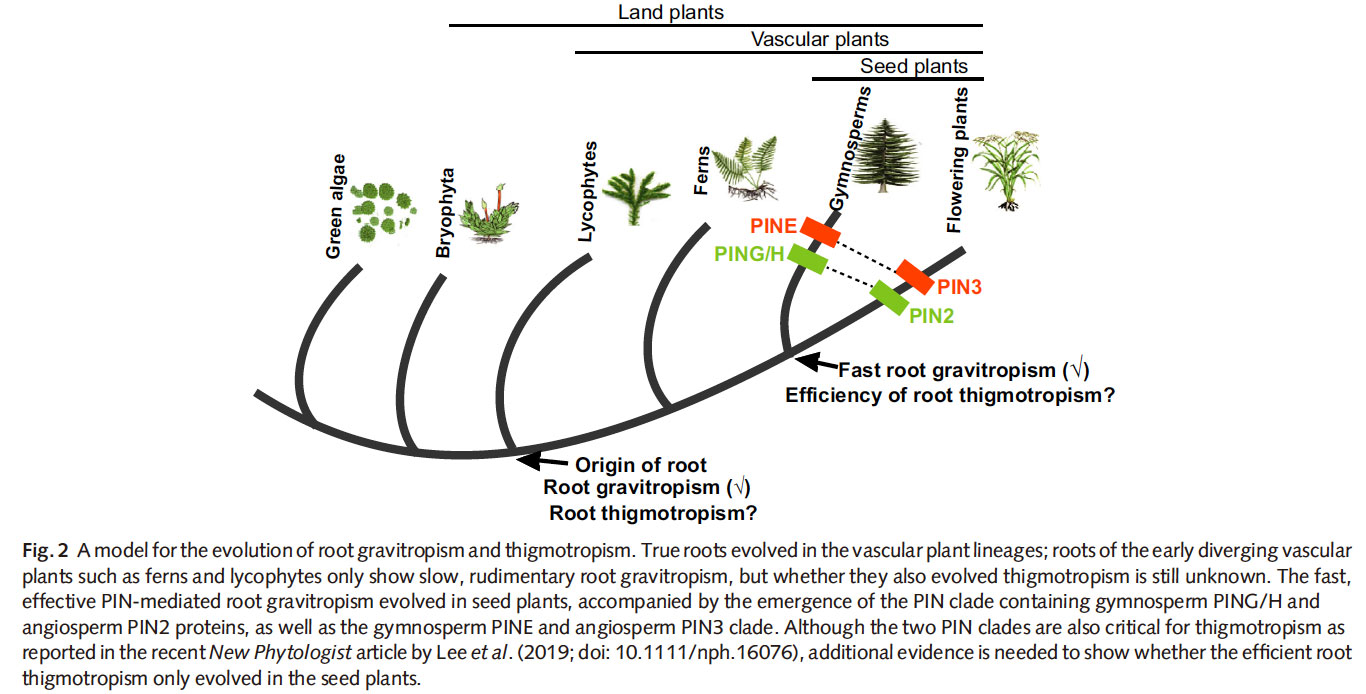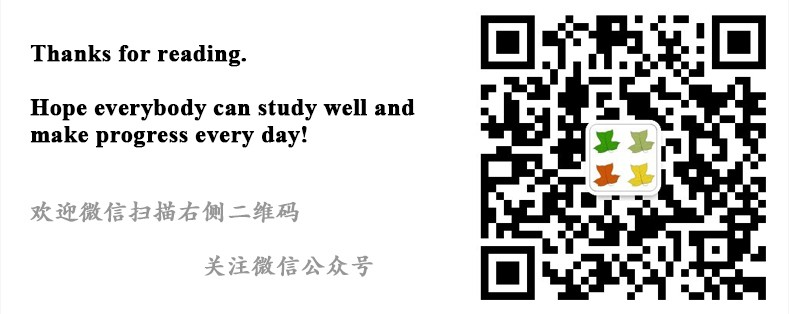博文
New Phytologist:植物生长素指导根在向重力性生长过程中如何避免障碍物
||
Auxin guides roots to avoid obstacles during gravitropic growth
First author: Yuzhou Zhang; Affiliations: Institute of Science and Technology (奥地利科学技术研究所): Klosterneuburg, Austria
Corresponding author: Jiří Friml
Unlike animals, plants are sessile organisms that are unable to flee from adverse conditions. Plants anchor themselves in the soil and must be able to rapidly adapt to an unfavorable or changing environment. Over the course of evolutionary time, in order to colonize diverse habitats on land, plants have evolved formidable capabilities to sense changes in their surroundings and to quickly respond by altering their direction of growth (Sato et al., 2015).These movements, by which plants grow either towards or away from stimuli, such as light and gravity, are termed tropisms. The phenomenon of plant tropism has fascinated botanists for hundreds of years, and this interest led to the identification of the plant hormone auxin and its crucial role in mediating this biological process. The mechanism of root gravitropism evolved in higher plants (Zhang et al., 2019a) and it is driven by the auxin redistribution between the lower and upper side of the root, which is mediated by PIN auxin efflux transporters (Luschnig et al., 1998; Friml et al., 2002; Baster et al., 2013). This auxin gradient leads to differential growth rates that then cause the root to bend in the direction of the Earth's gravity. Similar to gravitropism, root thigmotropism is a crucial process allowing plants to deal with impenetrable obstacles in their surroundings, such as rocks in the soil, facilitating the rapid bending of roots away from the obstacles and finding their edge (Braam, 2005). The combination of both root obstacle avoidance and root gravitropism enables the roots to grow downward into deep soil to access water and nutrients. However, distinct from root gravitropism, in which bending relies on the PIN‐mediated intercellular auxin transport, the mechanism underlying root bending during obstacle avoidance has been largely unknown. The recent article in New Phytologist by Lee et al. (2019; doi:10.1111/nph.16076) unambiguously shows that the first bending of thigmotropism is not simply a passive result of the root growth against a barrier, but it involves active signal transduction that requires asymmetric auxin distribution and differential cell elongation between the convex and concave sides of the Arabidopsis root (Lee et al.). Additionally, the Lee et al. study reveals that besides the PIN‐mediated auxin transport, root obstacle avoidance depends also on the TRANSPORT INHIBITOR RESPONSE1/AUXIN SIGNALING F BOX PROTEIN (TIR1/AFB) auxin signaling pathway. These findings provide crucial insights into the working machinery of root obstacle avoidance.
与动物不同,植物是固着生物,并不能从不利的环境中逃离。植物将本身固定在土壤之上,必需要能够快速适应不利的或者变化的环境。在演化的时间长流中,为了能够殖民不同的陆地生境,植物演化出了强大的感知周遭环境的能力,并且能够通过改变本身的生长方向快速响应。这种植物朝向或者背向光或者重力等刺激的移动叫做向性。植物学家对于植物的向性现象着迷了数百年,并在此过程中鉴定到了一种植物激素,即生长素,及其在植物向性中重要作用。植物的向重力性在高等植物中演化出来,该现象是由生长素在根的上下部重新分布所导致的,而该过程则是由生长素外输蛋白PIN所介导的。生长素梯度导致了差异生长,进一步导致了根朝向地球引力的方向弯曲。与向重力性相似,根的向触性是植物面对土壤中根周的石头等坚硬障碍物时的解决方案,促进植物的根快速弯曲并绕过障碍物,并且发现障碍物的边缘。根的避障机制与向重力性的组合使得根能够生长到更深的土壤中去,从而获取水分和营养。然而,与根向重力性依赖于PIN介导的细胞间生长素运输不同的是,根的避障反应背后潜在的分子机制还不清楚。最近Lee等人发表于New Phytologist上的一篇研究论文明确地指出了根向触性的第一次弯曲不仅是一次简单的根遇到障碍物时的被动生长响应,该过程涉及了主动的信号转导,并且需要拟南芥根凸、凹面上的生长素不对称分布以及差异性细胞伸长。另外,Lee等人还揭示了除了PIN介导的生长素运输以外,根的避障响应还依赖于TIR1/AFB生长素信号转导途径。这些研究为根的避障机制提供了重要的见解。
To better understand the mechanism of obstacle avoidance during root–obstacle interactions, let us compare root gravitropism with root thigmotropism. Generally, root tropism can be divided into three temporally distinct phases: (1) perception of the environmental cue, (2) transmission of the perceived signal and, (3) ultimately, the growth response itself (Sato et al.,2015).
For root gravitropism, the root apex is the primary site where gravity is sensed (Sato et al., 2015). The dense starch‐filled amyloplasts within the root apex sediment in the direction of the gravity vector, enabling higher plant roots to perceive the gravity field (Fig. 1). However, it is still unknown which part of the root is used for the obstacle perception, even though it seems plausible that the root apex could be the site of the touch sensor due to its immediate physical interaction with the obstacle. Additionally, it is also unknown which component(s) or organelles in the root cells are utilized to perceive the mechanical force, and how they convert the physical touch signal to the auxin signal.
Gravitropic signal transduction involves transmission of auxin signal from the place of gravity perception in the root tip to the place of growth response in the elongation zone and involves both auxin importer and exporter proteins from the AUX1/LAX1 and PIN families, respectively (Sato et al., 2015). Following gravistimulation, the originally symmetrically placed PIN3 and PIN7 are rapidly relocalized to the new bottom side of the columella cells within the root apex, thus diverting auxin flow to the lower side of the root tip (Friml et al., 2002). From there auxin is further transported by the action of PIN2 towards the elongation zone. This asymmetric auxin flow is further reinforced by the PIN2 stabilization in cells along the lower side of the root and its destabilization at the opposite root side (Baster et al., 2013) (Fig. 1). Similar to root gravitropism, asymmetric auxin flow is also observed during root obstacle avoidance, as clearly indicated by the asymmetric expression of auxin response indicators, DR5rev:GFP and DII‐VENUS (Lee et al.). Pharmacological and genetic experiments demonstrate that the auxin asymmetry in thigmotropism also depends on the PIN auxin transporter activity (Lee et al.). It remains to be demonstrated, however, whether the PIN relocalization and the asymmetric degradation also occurs during root obstacle avoidance, as it does in root gravitropism (Fig. 1).
Once it has arrived at the elongation zone, by the PIN2 action, the auxin signal is ultimately converted to the asymmetric growth, resulting in root bending along the gravity vector. Notably, unlike in root gravitropism, for which the bending initiates in the distal elongation zone (DEZ), the first bending in root thigmotropism occurs in the central elongation zone (CEZ) above the DEZ (Fasano et al.,2002). In gravitropism, auxin inhibits growth at the lower root side by the rapid action of TIR1/AFB auxin signaling (Fendrych et al., 2018). Similarly, root bending in thigmotropism also depends on the TIR1/AFB‐mediated auxin signaling (Lee et al.; Zhang et al., 2019b), but the details of the downstream cellular processes leading to growth regulation are unclear in both types of tropism (Fig. 1).

为了更好地理解植物根与障碍物互作过程中的避障反应机制,作者比较了根的向重力性与根向触性的异同。一般来说,根的向性可以在时间上被划分为三个不同的阶段:(1)感知外界环境信号;(2)感知信号的转导;(3)最终,诱导本身的生长响应。
对于根的向重力性而言,根尖是感知重力的主要部位。根尖中,在重力矢量方向上沉积的密集淀粉填充的淀粉质体使得高等植物的根能够感知重力场。然而,目前还不清楚根的哪个部分作用于根对于障碍物的感知,即使看起来根尖由于其与障碍物直接的物理互作,可能作为根的触碰传感器位置似乎也是合理的。另外,根细胞中哪种组分或者细胞器被用来感知机械压力的,以及如何将这种物理触碰转化为生长素信号的还不清楚。
重力信号转导涉及根尖感知信号位点到根伸长区生长响应位点的生长素信号传递,并且同时涉及到生长素输入蛋白AUX1/LAX1家族和输出蛋白PIN家族。在受到重力刺激后,原先对称分布的PIN3和PIN7会快速重定位到新的根尖柱状细胞的底面,从而将生长素流转向到根尖的下侧。从这儿,生长素会进一步被PIN2朝向伸长区转运。根下侧排列的细胞中PIN2蛋白的稳定以及对面一侧细胞中PIN2蛋白的不稳定进一步加强了这种不对称的生长素流。与根的向重力性类似,在根避开障碍物生长的过程中出现了生长素响应指标DR5rev:GFP和DII‐VENUS的不对称表达,预示着不对称的生长素流。药理和遗传试验表明,根的向触性过程中生长素的不对称性依赖于生长素运输蛋白PIN的活性。然而,有关根向重力性过程中的PIN重定位以及不对称降解是否也在向触性过程中存在还有待进一步的了解。
一旦PIN2介导的生长素流到达伸长区,生长素信号最终会被转化成不对称生长,导致根沿着重力矢量方向的弯曲。值得注意的是,与根的向重力性过程中弯曲起始于末端伸长区DEZ不同,根向触性的第一次弯曲发生在DEZ区上方的中部伸长区CEZ。在向重力性中,生长素会通过快速的TIR1/AFB生长素信号转导抑制下侧根的生长。类似的是,根向触性弯曲过程同样依赖于TIR1/AFB介导的生长素信号转导,但这两种向性中具体的下游控制生长的细胞学过程都还不清楚。
In addition to auxin, several other signals, such as calcium ion (Ca2+), pH and reactive oxygen species (ROS) have been implicated in the regulation of both root gravitropism and thigmotropism (Nakagawa et al., 2007) (Fig. 1). During root bending, the cytosolic Ca2+ concentration rapidly increases in the epidermal cells on the convex root side, and the increased Ca2+ levels are linked with the production of apoplastic ROS and cytoplasmic acidification, which are involved in cell elongation (Monshausen et al., 2009). Regarding root gravitropism, it has been observed that auxin distribution is somehow linked to the cytosolic Ca2+ wave (Sato et al., 2015; Su et al., 2017) and Ca2+, in turn, regulates PIN localization and gravitropism (Zhang et al., 2011). It seems plausible that the PIN‐mediated auxin redistribution in root thigmotropism may also trigger Ca2+ signaling; however, it remains to be addressed. Notably, the Lee et al. study also nicely shows that inhibition of Ca2+ signaling blocks the asymmetric auxin distribution, suggesting a more complex feedback regulation between the auxin and Ca2+ signaling pathways during root bending in both contexts. Among the outstanding questions are whether auxin and Ca2+ act in a common or parallel signaling pathway in the regulation of tropisms and what are the upstream and downstream processes?
生长素之外,还有一些其他的信号,比如钙离子、pH以及活性氧物质ROS作用于根的向重力性和向触性运动。在根弯曲的过程中,凸侧表皮细胞中胞质的钙离子浓度会快速上升,并且升高的钙离子水平与参与细胞伸长的质外体ROS产量以及胞质酸度相关。而关于根的向重力性,已经有研究报道了生长素的分布以某种方式与胞质的钙离子波动相关联,并且钙离子反过来会调控PIN的定位与向重力性。似乎在根向触性过程中PIN介导的生长素重分布同样会诱导钙离子信号也是合理的,然而,还需要进一步的实验证据。值得注意的是,Lee等人的研究还显示抑制钙离子信号会阻断不对称的生长素分布,说明根弯曲过程中在生长素和钙离子信号之间存在一个更加复杂的反馈调控机制。现在悬而未决的问题是生长素和钙离子分别平行作用于,亦或是在同一信号通路中作用于植物的向性调控,以及上下游的分子调控机制是什么?
Notably, observation of Arabidopsis root movement has revealed that root bending takes place within 20 min after contact with the barrier (Lee et al.), indicating that root obstacle avoidance might be a rapid process. Recently, it has been shown that root gravitropism in flowering plants is also highly efficient when compared with that in basal vascular plants such as lycophytes and ferns (Zhang et al., 2019a). These results imply that, to better adapt to terrestrial environments with constantly changing environments, higher plants evolved more efficient tropism responses compared with their predecessors, to facilitate their successful colonization of the land. Rapid, efficient root gravitropism evolved in seed plants (i.e. gymnosperms and flowering plants); nevertheless, it is unclear when during evolution active, efficient thigmotropism appeared (Fig. 2). Studies have revealed that efficient tropism relies on the PIN3 clade (PIN3/4/7 in Arabidopsis) and the PIN2 clade in flowering plants (Zhang et al., 2019a), since these PIN genes are able to rapidly adjust and redirect the auxin flow (Su et al., 2017). Analysis of the PIN phylogeny and comparison of the root structures implies that efficient thigmotropism could have also evolved only in seed plants. Based on the phylogenetic tree of PIN protein sequences, the gymnosperm PINH/G proteins are in the same clade as flowering plant PIN2, and interspecies complementation reveals that their functions are equivalent in root gravitropism, while the gymnosperm PINE groups in the same clade with flowering plant PIN3/4/7 (Fig. 2). However, the proteins in the two PIN clades are not present in lower plants including the ferns and lycophytes (Bennett et al., 2014) (Fig. 2). Additionally, the anatomic root structure of seed plants is quite distinct as compared to the roots of early diverging extant vascular plants, lycophytes and ferns (Zhang et al., 2019a). Thus, it still needs to be clarified whether basal vascular plants possess similar thigmotropic activity as found in flowering plants, and if so, if their roots utilize the PIN proteins from the other clades to regulate this process. Such studies would shed light on an eventual co‐evolution of root thigmotropism and gravitropism, revealing how plants after colonizing land ‘learned’ to deal with challenging conditions of growing through different types of soils.

值得注意的是,对拟南芥根移动的观察表明根的弯曲发生在与障碍物接触后的20分钟内,这说明根的避障反应应该是一个快速的过程。最近的研究表明,与苔藓、蕨类植物等基础的维管植物相比,有花植物的根向地性十分有效。这些结果暗示,为了更好地适应不断变化的陆地环境,高等植物演化出了较祖先更有效的向性反应,以促进其成功的陆地殖民。根向地性在包含裸子植物和有花植物的种子植物中快速有效地演化;但尚不清楚在演化过程中何时出现有效的向触性。研究表明,有效的向性运动依赖于有花植物中的PIN3进化枝(拟南芥中的PIN3/4/7)和PIN2进化枝,因为这些PIN基因能够快速调节和重定向植物的生长素流。 PIN系统发育分析和根系结构比较表明,有效的向触性也可能仅在种子植物中演化。基于PIN蛋白质序列的系统发育树,裸子植物PINH/G蛋白与有花植物PIN2位于同一进化枝中,种间互补试验表明其功能在根向重力性方面的作用是相同的,而裸子植物PINE与有花植物的PIN3/4/7位于同一进化枝。然而,这两个PIN进化枝中的蛋白质不包含蕨类和苔藓植物在内的低等植物。此外,与早期分化的现存维管植物、苔藓植物和蕨类植物的根相比,种子植物的解剖根结构非常不同。因此,仍然需要弄清基础维管植物中是否已经存在与有花植物中相似的向触性运动,如果是,则其根是否会利用其他进化枝的PIN蛋白来调控该过程。这样的研究将会为根的向触性和向重力性的最终共同演化提供新的视野,揭示在殖民陆地后植物如何“学习”以应对在不同类型土壤条件下生长。
通讯:Jiří Friml (https://ist.ac.at/research/research-groups/friml-group/)
个人简介:1995年,马萨里克大学,化学学士;1997年,马萨里克大学,生物化学学士;2000年,科隆大学,生物学博士;2002年,马萨里克大学,生物化学博士。
研究方向:生长素的极性运输;细胞极性;细胞内吞与再循环;信号转导的非转录机制。
doi: https://doi.org/10.1111/nph.16203
Journal: New Phytologist
First Published: October 21, 2019

https://blog.sciencenet.cn/blog-3158122-1203136.html
上一篇:New Phytologist:植物PIN介导的极性生长素运输作用于根的避障反应
下一篇:Current Biology:早期被子植物生根系统演化
全部作者的其他最新博文
- • Plant Physiology:CsMADS3促进柑果中的叶绿素降解和类胡萝卜素合成(华中农业大学)
- • Molecular Plant:LBD11-ROS反馈调节作用于拟南芥的维管形成层增殖和次生生长(浦项科技大学)
- • Science Advances:根结线虫通过调控植物的CLE3-CLV1模块,促进侵染进程(日本熊本大学)
- • Nature Communications:油菜素内酯参与植物营养生长期转变的分子机制解析(浙江农林大学)
- • Current Biology:光合作用产生的蔗糖驱动侧根“生物钟”(德国弗莱堡大学)
- • PNAS:花同源异型基因在叶中被抑制、花中被激活的分子机制(南卡罗来纳大学)